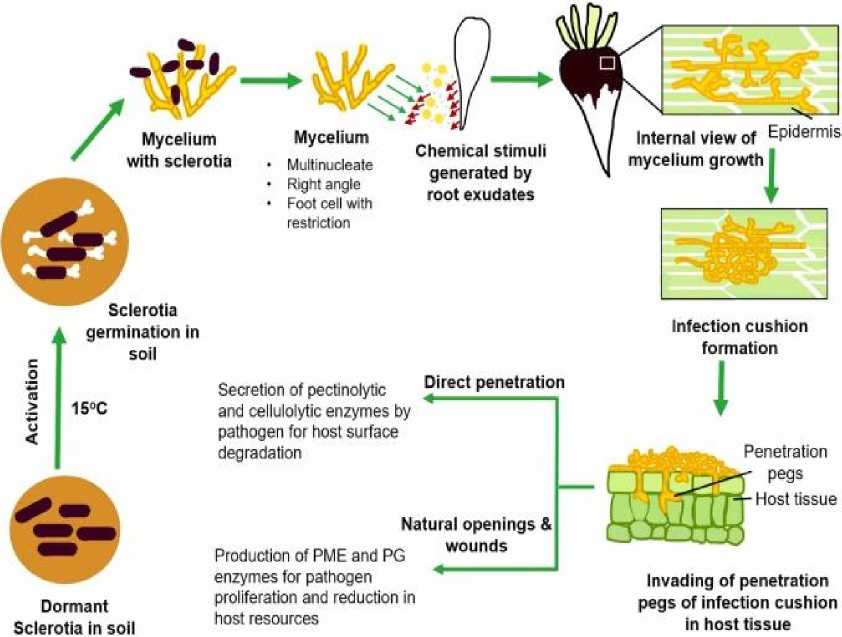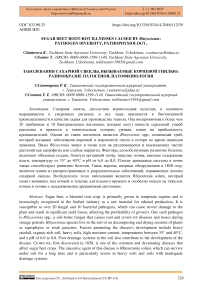Sugar beet root-rot illnesses caused by Rhizoctonia: pathogen diversity, pathophysiology
Автор: Sattarova R., Soatov T.
Журнал: Бюллетень науки и практики @bulletennauki
Рубрика: Сельскохозяйственные науки
Статья в выпуске: 3 т.11, 2025 года.
Бесплатный доступ
Sugar beet, a biennial root crop, is primarily grown in temperate regions and is increasingly recognized in the biofuel industry as a raw material for ethanol production. It is susceptible to over 20 fungal and 10 bacterial pathogens, which can cause severe damage to the plant and result in significant yield losses, affecting the profitability of growers. One such pathogen is Rhizoctonia spp., a soil-borne fungus that causes root and crown rot diseases and losses during storage periods. Rhizoctonia species live in the soil or on decomposing and drying sections of plants as saprophytes or weak parasites. Factors promoting the disease's development include heavy rainfall, organic-rich soil, heavy soils, high moisture content, temperatures between 35° and 40°C, and a pH of 6.0 to 8.0. Poor drainage systems in the soil also contribute to the development of the disease. Crown rot, first discovered in 1858, is one of the common and devastating diseases that affect sugar beet crops. The causative agent of this disease is Rhizoctonia solani, which can survive under soil for a long time and is particularly severe in heavy soils and soils with inadequate drainage systems.
Disease, rhizoctonia solani, soils, pathogen
Короткий адрес: https://sciup.org/14132517
IDR: 14132517 | УДК: 632.98.25 | DOI: 10.33619/2414-2948/112/39
Текст научной статьи Sugar beet root-rot illnesses caused by Rhizoctonia: pathogen diversity, pathophysiology
Бюллетень науки и практики / Bulletin of Science and Practice
UDC 632.98.25
A healthy crop is the only way to achieve high production and high yield. Sugar beet ( Beta vulgaris L.), a biennial root crop that belongs to the Chenopodiaceae family and is known for producing sugar after sugarcane, is primarily grown in temperate regions of the world and is increasingly being recognized in the biofuel industry as a raw material for ethanol production. Sugar beet is susceptible to more than 20 fungal and 10 bacterial pathogens, which can cause severe damage to the plant and result in significant yield losses, which affects the profitability of the growers [9].
Of these pathogens, Rhizoctonia spp. is a soil-borne fungus that is common and extremely harmful, causing root and crown rot diseases and causing losses during the storage period of sugar beets. Root rot diseases are a constraint in producing sugar beets of quality standards as per the millers' requirement for obtaining high sugar recovery [1]. On the other hand, low-quality beets cause a reduction in root weight and sugar recovery, along with additional losses during storage. The degree of damage caused by this fungus varies and is dependent on environmental factors.
Depending on the intensity of the fungal infection, crop loss can range from 0% to 50%, or even >50–60%, and occasionally crops may fail entirely. Additionally, it was noted that infected sugar beets lost between 5 and 10% of their recoverable white sugar.
Stalk discolouration is a sign of Rhizoctonia disease in sugar beets, however it's sometimes mistaken for symptoms of Pythium and Aphanomyces-caused disease or lightening damage. Rhizoctonia species live in the soil or on the decomposing and drying sections of plants as saprophytes or weak parasites. Heavy rainfall, organic-rich soil, heavy soils, and high moisture content, temperatures between 35° and 40°C, and a pH of 6.0 to 8.0 that is favorable for the formation of the fungus's sclerotia in sugar beet are all factors that promote the disease's development. The development of the disease is also influenced by a poor drainage system in the soil. The number of sclerotia of the pathogen is based on the severity of the infection and is most commonly found in organic leftovers within 10 cm of the top surface [10].
This review provides a thorough update on the pathogen diversity, pathogenesis, and anastomosis groups of this fungus, as well as a summary of sugar beet varietal improvement and advancements in management research of diseases caused by Rhizoctonia through biotechnological methods and biological control. In 1858, Julius Kuhn made the initial discovery of crown rot, one of the common and devastating diseases that affect sugar beet crops. The causative agent of Rhizoctonia crown and root rot is Rhizoctonia solani. This illness can survive under soil for a long time. Although this disease can occur in practically any type of soil, it is particularly severe in heavy soils and soils with inadequate drainage. systems [2].
In most growing locations, outbreaks of this fungus start when the canopy develops typically in June. However, the majority of symptoms appear in the late summer or early fall months. About 10% to 15% of Europeans suffer economic losses as a result of this condition, and the rate is increasing as it becomes more severe. This damage has increased to 30% in the USA [7]. Significant yield loss (>50%) is the outcome of severe crown rot infestations. These losses result from lesser sugar recovery during processing and decreased tonnage brought on by diseased or damaged roots [5].

Mycelium with sclerotia
Infection cushion formation
Invading of penetration pegs of infection cushion in host tissue
Internal view of Epidermis mycelium growth
Sclerotia
Dormant Sclerotia in soil
Production of PME and PG wounds enzymes for pathogen proliferation and reduction in host resources
Penetration г pegs r Host tissue
Mycelium
• Multinucleate
• Right angle
• Foot cell with restriction
Chemical stimuli generated by root exudates
15°C germination in soil
Secretion of pectinolytic and cellulolytic enzymes by pathogen for host surface degradation
Direct penetration
Figure. Generalized life cycle of Rhizoctonia spp. in sugar beet causing root rot disease Chemical stimuli generated by root exudates of the sugar beet attracts the mycelium/ hyphae of Rhizoctonia solani towards itself for its growth and proliferation acting as a nutrient source. The mycelia/ hyphae get attached to sugar beet root surfaces particularly epidermis leading to formation of infection cushions and later to penetration pegs. direct penetration, natural openings, or wounds on the surface are the three means through which these penetration pegs enter into the root. Secretion of enzymes by plants have significant functioning in host surface degradation. PME- Pectin-methyl-esterase; PG- polygalacturonase enzymes. (Varucha Misra)
The onset of this disease infection is characterized by sudden or permanent withering of leaves (especially older leaves) and shoots with changes in the color of petiole bases (dark-brown to black staining; Richards, 1921) [3]. Damage to the vascular system could be the cause of this. There may or may not be leaf yellowing. In a number of instances, a proximal section of the root separated along with all of the leaves. The spongy, rotting, brown to blackish symptom begins at the root's surface and then spreads several centimeters deep into the skin. superficial lesions that have a distinctive.
The fungus R. bataticola is the cause of the disease known as "charcoal root rot," which causes severe damage to sugar beet crops and results in significant yield losses. The disease was first discovered in the Sacramento Valley in 1932 and has an incidence rate ranging from 8% to 30%. The fungus attacks fully or half-mature sugar beet roots, causing them to become weak, have low nutrient uptake, and stunted growth. These roots have small tap roots and low sugar content. Warm temperatures, usually between 20°C and 30°C (68 and 86°F), as well as high soil moisture levels and compacted or heavy soils, are conducive to the development of charcoal root rot.
On the bases of petioles and the upper root area, distinctive symptoms appear. On the affected areas, several small, spherical, dark-black sclerotia form. There are yellow mustard lesions on the inside of the root crown and brown black lesions on the outside. Sclerotria develop in the rotten sections of the roots during the advanced stages. Additionally, mummified roots have been found [6].
On the bases of the petiole, the fungus also produces pycnidia, another kind of fruiting body, in addition to sclerotia. The dense reddish purple fungal mycelial growth on sugar beet roots is what gives the disease its name: violet root rot. Though it has been recorded from some parts of the US and Asia, the disease caused by this fungus is more common throughout Europe and a major problem in Spain's sugar beet farming regions [4].
Rhizoctonia crocorum , also known as Rhizoctonia violecea, is the cause. This species of Rhizoctonia, known as binucleate, is entirely distinct. Helicobasidium brebissonii is the ideal stage of this fungus. The occurrence of the disease is typically observed at the end of the sugar beet crop season. Most soil types are susceptible to this disease, although light sandy gravelly or peaty loams are most susceptible.
Список литературы Sugar beet root-rot illnesses caused by Rhizoctonia: pathogen diversity, pathophysiology
- Büttner G., Pfähler B., Märländer B. Greenhouse and field techniques for testing sugar beet for resistance to Rhizoctonia root and crown rot // Plant breeding. 2004. V. 123. №2. P. 158-166. DOI: 10.1046/j.1439-0523.2003.00967.x EDN: FMLXVP
- El-Tarabily K. A. Suppression of Rhizoctonia solani diseases of sugar beet by antagonistic and plant growth-promoting yeasts // Journal of Applied Microbiology. 2004. V. 96. №1. P. 69-75. DOI: 10.1046/j.1365-2672.2003.02043.x
- Haque M., Parvin M. Sugar beet, it ‘disease Rhizoctonia root rot, and potential biological agents // Agricultural and Biological Research. 2021. V. 37. №1. P. 96-101.
- Hecker R. J., Ruppel E. G. Rhizoctonia root rot resistance in sugar beet: breeding and related research // J. Am. Soc. Sugar Beet Technol. 1977. V. 19. №3. P. 246-256.
- Herr L. J. Sugar Beet Diseases Incited by Rhizoctonia Spp //Rhizoctonia species: taxonomy, molecular biology, ecology, pathology and disease control. Dordrecht: Springer Netherlands, 1996. P. 341-349. DOI: 10.1007/978-94-017-2901-7_31
- Hillnhütter C., Mahlein A. K., Sikora R. A., Oerke E. C. Remote sensing to detect plant stress induced by Heterodera schachtii and Rhizoctonia solani in sugar beet fields // Field Crops Research. 2011. V. 122. №1. P. 70-77. DOI: 10.1016/j.fcr.2011.02.007 EDN: SRRDOF
- Larson R. L., Hill A. L., Fenwick A., Kniss A. R., Hanson L. E., Miller S. D. Influence of glyphosate on Rhizoctonia and Fusarium root rot in sugar beet // Pest Management Science: formerly Pesticide Science. 2006. V. 62. №12. P. 1182-1192. DOI: 10.1002/ps.1297
- Misra V., Mall A. K., Singh D. Rhizoctonia root-rot diseases in sugar beet: Pathogen diversity, pathogenesis and cutting-edge advancements in management research // The Microbe. 2023. V. 1. P. 100011. DOI: 10.1016/j.microb.2023.100011 EDN: ZPKMTC
- O'sullivan E., Kavanagh J. A. Characteristics and pathogenicity of isolates of Rhizoctonia spp. associated with damping-off of sugar beet // Plant pathology. 1991. V. 40. №1. P. 128-135. DOI: 10.1111/j.1365-3059.1991.tb02301.x
- Scholten O. E., Panella L. W., De Bock T. S., Lange W. A greenhouse test for screening sugar beet (Beta vulgaris) for resistance to Rhizoctonia solani // European Journal of Plant Pathology. 2001. V. 107. P. 161-166. :1011208903344. DOI: 10.1023/A EDN: AMFRUP


